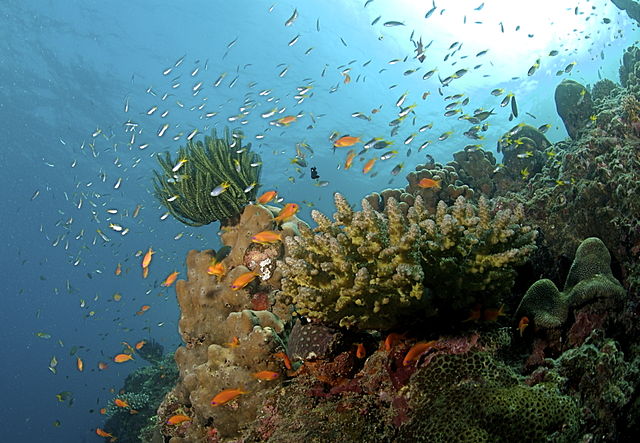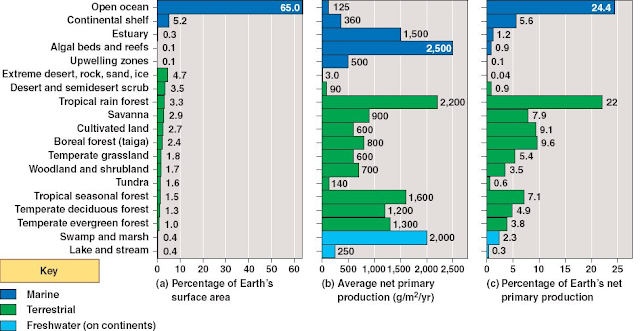 |
| Ecosystem (Ecology) |
Factors which Influence the Ecosystem
Ecosystems are controlled by both internal and external factors.
Internal factors not only control the ecosystem but also get influenced by the changes in the ecosystem. These internal factors work as the critic or feedback providers of the ecosystem. The process like decomposition and root competition are the primary examples of the internal factors.
On another hand, the external factors are those factors which control the ecosystem but do not get affected by the ecosystems. Climate, sunlight, temperature, soil and topography are the major external factors.
Components of the Ecosystem
There are four major components of the ecosystem
1. Productivity
2. Energy Flow
3. Decomposition
4. Nutrient Cycle
Productivity
Energy is the basic requirement for any ecosystem to function and sustain. The primary producers such as plants and other autotrophs produce food through photosynthesis which uses sunlight (or solar energy) or in some case through chemosynthesis which uses the energy released during oxidation or reduction for the production. Every living organism on the Earth relies on the primary production in some or another way. The primary production can be defined as the amount of biomass (organic matter) produced per unit area over a period of time. It is expressed in terms of weight or energy. The rate at which organic matter is produced each year is known as the productivity. It is expressed in terms of energy per year.
The productivity is again divided into Gross primary productivity (GPP) and Net primary productivity (NPP). GPP is the rate of biomass production through photosynthesis. A much amount of this production is used by plants themselves for respiration. When this consumed amount is subtracted from GPP, the NPP is left.
GPP - R = NPP
The Net Primary Productivity can be defined as the available biomass for heterotroph consumption. On the basis of net primary productivity, we can say coral reefs and tropical rain forests are two most ecologically important ecosystems.
 |
| Net Primary Productivity in Different Ecosystems |
The secondary productivity can be defined as the biomass or organic matter produced by the heterotrophs. Sometimes, secondary productivity is defined as the biomass produced by the herbivorous. Similarly, tertiary productivity can be defined as the biomass produced by the carnivorous.
Decomposition
The process of breaking down complex organic matter into inorganic matter such as carbon dioxide, water and nutrients are known as the decomposition. It is carried out by the detritivores and decomposers. The detritivores and decomposers are interchangeably used, but detritivores for example earthworms feed on detritus and decomposers for example bacteria and fungi absorb the material. The decomposing plant and animal remains as well as faeces are together known as the detritus. The major steps in decomposition are fragmentation, leaching, catabolism, humification and mineralisation.
First, detritivores break down detritus into smaller particles. This process is simply known as fragmentation. It is followed by the process of leaching, in which water-soluble inorganic nutrients get either dissolve into water or seep into the soil and get percipated. Simultaneously, bacterias and fungi convert detritus into more simpler inorganic compounds. This process is known as catabolism. It should be remembered, these three process fragmentation, leaching and catabolism happen simultaneously.
However, further decomposition of detritus by a microorganism leads to humification and mineralization. Mineralization and humification happen simultaneously. The humification leads to the formation of a dark coloured amorphous compound which is known as humus. The humus improves the soil texture and its fertility. On the further decomposition of humus, it leads to the release of inorganic nutrients, which is known as the mineralization.
The rate of decomposition is determined by the factor such as temperature, availability of oxygen, humidity, rainfall and organic makeup of the detritus.
Energy Flow
The solar energy gets fixed by autotrophs. The autotrophs are known as primary producers in terms of ecology. The plants capture 2-10 per cent of the photosynthetically active radiation (PAR) and convert this energy into food.
Animals eat the plant produce and they are rightly known as the primary consumers. The herbivores are the major primary consumers.
The herbivores are also known as the secondary producers as the carnivores feed on the meat and fat produced by them. The carnivores, on the other hand, are known as secondary consumers.
Then comes the tertiary consumers who feed on these primary and secondary producers. The tertiary consumers are at the top of the food chain. Tertiary consumers can be carnivores or omnivores. The omnivores are animals who eat both plant and meat.
Finally, decomposers and detritivores come into the play who decompose the decaying parts of the plants and consumers. They release nutrients into the soil.
The energy transfer from primary to the tertiary consumer is known as the grazing food chain (GFC) whereas the transfer from detritus to the fixing of nutrients into the soil is known as the detritus food chain (DFC).
In aquatic ecosystems, the energy flow is generally maintained by GFC. This is against the terrestrial ecosystem, whereas DFC forms the major part of energy flow. Sometimes, the components of DFC and GFC interact with each other and they form the food web. For example, earthworms (decomposers) are eaten by hens which are in turn eaten by man.
Ecological Pyramids
Based on the source of food or energy, organisms can be divided on the basis of their tropic level. The producer such as plants belongs to first trophic level; primary consumers such as cattle and pigs belong to the second trophic level, secondary consumers such as birds or fishes belong to third trophic level and finally, tertiary consumers like man and lion belong to fourth trophic level. Each trophic level has a certain mass of living material which is known as the standing crop and it is measured in terms of biomass per unit area. The biomass is again expressed on two levels: fresh and dried biomass.
The relationship between all the trophic levels is graphically expressed in terms of pyramids. These pyramids are known as ecological pyramids. The producers form the base of these pyramids and subsequently, tertiary consumers are on the top of these pyramids. These pyramids are studies on the basis of the number of the organism, biomass and energy. Henceforth, there is (a) pyramid of number; (b) pyramid of biomass and (c) pyramid of energy.
A given organism can take up more than one level. For example, a bird is on the secondary trophic level when it eats the fruits and seeds, and the same bird is on the tertiary level when it eats the insects.
Mostly, pyramids of number, energy and biomass go upright, but in the case of the pyramid of biomass in the sea, it is inverted.
Ecological Succession
As we know, the change in the surrounding environment leads up to the change in the population of different organisms and their interaction. This gradual change is known as ecological succession. There are two types of ecological succession: Primary Succession and Secondary Succession. The primary succession generally happens at the newly formed area such newly cooled lava bed or newly formed pond. The establishment of biotic communities on the newly formed area can take a long time ranging from hundreds to ten thousands of years. On the other side, secondary succession happens at a previously destroyed region such as abandoned farmland or burned forests. It happens at a very quick pace.
On the basis of habitat, there are two types of plant succession: Hydrach succession and Xerach succession. The hydrach succession takes place at wetter places whereas xerarch succession takes place in the drier area.
Nutrient Cycling
The movement of nutrients through various biotic and abiotic components of the ecosystem is known as the nutrient cycling. The process is also known by the names of mineral cycling and biogeochemical cycling. There are two types of nutrient cycling: 1. gaseous and 2. sedimentary. The nitrogen, oxygen, carbon and water cycles are the primary examples of the gaseous nutrient cycle whereas the calcium, phosphorus, sulfur and iron cycles are the examples of the sedimentary nutrient cycle.
Source: NCERT Class 12 Biology Chapter 14 Ecosystems
Graph Source: Nicerweb
